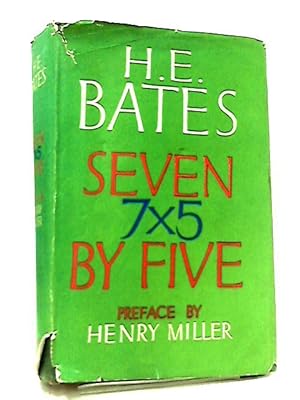Seven by Five.

London: Michael Joseph, 1963; Boston, Toronto: Little, Brown, and Company (an Atlantic Monthly Press Book), 1963 (with title The Best of H.E. Bates). Preface by Henry Miller. The American title is similar to the posthumous collection The Best of H.E. Bates, A Selection of Novels and Short . The collection was reprinted as one volume in Country and Other Matters.
In his "Author's Note" (attached) Bates explains his choices of stories, which range from 1926 to 1961. Containing surprisingly few early tales (only nine first published prior to 1940), the collection draws heavily from five collections published between 1951 and 1961 -- Colonel Julian and Other (1951, six selections), The Daffodil Sky (1955, nine selections), TheWatercress Girl (1959, five selections), and Now Sleeps the Crimson Petal and other stories (1961, six selections). With two exceptions, all of the stories are serious rather than comic; Bates, who did not appreciate the criticism that with the Larkin Family novels he had become less than a serious writer, may have done this intentionally (in a letter quoted by Baldwin (219) Bates writes that "No one can deny that a great part of my work is of a somber and indeed tragic mould"). Six of the tales represent one of Bates's great strengths, the portrayal of childhood in nature, and a surprising seven tales approach or exceed in length other works excluded as "novellas," indicating the somewhat arbitrary distinction between a long story and a novella. As Baldwin (211) notes, although surprised by the choice of Henry Miller for the book's introduction (attached), Bates was pleased with Miller's comments and the book's reviews. Miller, who admits to having been unfamiliar with Bates's work until a year before, says that it is "one of the great joys for a writer to find a fellow writer who, because he is so different, captivates and enchants him." Miller calls attention to Bates's appreciation of nature, his mature and well-rounded treatment of women, his "unswerving acceptance of life" and specifically of human pain and suffering, and his sense of humour, and the "lasting sensation of beauty" evoked by Bates's writing, which Miller compares to the skill of a painter.
A long and perceptive review in the Times Literary Supplement is titled "Epics in Miniature" and states that "the stories of H.E. Bates -- in spite of their author's present 'popularity' [referring to the Larkin Family novels] deserve the consideration and praise of any literary critic in the years to come."
Reviews:
New Statesman (September 13, 1963, p. 326, Brigid Brophy, attached)
Times Literary Supplement (September 13, 1963, p. 688, Julian Maclaren-Ross, attached)
Contains: The Flame; A Flower Piece; The Mower; Time; The Mill; The Station; The Kimono; Breeze Anstey; The Ox; Colonel Julian; The Lighthouse; The Flag; The Frontier; A Christmas Song; The Major of Hussars; Elaine; The Daffodil Sky; The Good Corn; Country Society; Across the Bay; Chaff in the Wind; The Evolution of Saxby; Go, Lovely Rose; The Maker of Coffins; Love in a Wych Elm; Let's Play Soldiers; The Watercress Girl; The Cowslip Field; Great Uncle Crow; The Enchantress; Now Sleeps the Crimson Petal; Where the Cloud Breaks; Lost Ball; Thelma; Mrs Eglantine.
| Attachment | Size |
|---|---|
| a98 Note.pdf | 162.62 KB |
| a98 Preface.pdf | 899.14 KB |
| a98 New Statesman.pdf | 306.49 KB |
| a98 TLS.pdf | 671.98 KB |